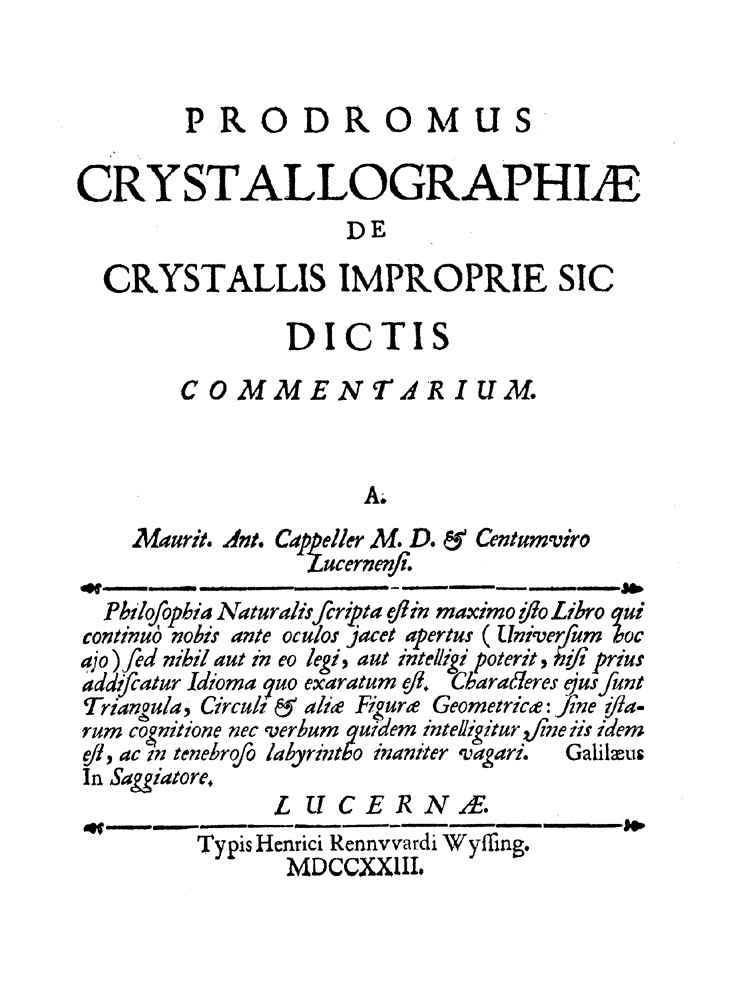CAPPELLER, Moritz Anton.
(1685 – 1769)
Cappeller was a physicain and a member of the high advisory council in Lucern. He worked as a field doctor for Swiss troops along the Italian border.
Biographical references: DBA: I 1426, 398-402. • Drugulin, Sechstausend Portraits, 1863: no. 831. • Fueter, Grosse Schweizer Forscher, 1941: portrait. • Lambrecht & Quenstedt, Catalogus, 1938: 227. • Poggendorff: 1, col. 373 & 7a, 129-30. • Sarjeant, Geologists, 1980: 2, 1421. • WBI. • Weber, Peter Xaver, "Dr. Moritz Anton Kappeller, 1685-1769," Der Geschichtsfreund. Mitteilungen des Historischen vereins der funf Orte Lucern, Uri, Schweiz, Unterwalden und Zug: 70 (1915), 157-249.

1. Latin, 1723.
Prodromus | Crystallographiæ | de | Crystallis Improprie Sic | Dictis | commentarium. | A. | Maurit. Ant. Cappeller M.D. & Centrumviro | Lucernensi. | [ornate rule] | [...7 lines of Latin quotation signed Galilæus Saggiatore...] | Lucernæ | [ornate rule] | Typis Henrici Rennvvardi Wyssing. | MDCCXXIII.
4°: 43 p., 3 engraved plates.
Very rare. An important and highly regarded crystallographic work, the Prodromus Crystallographiæ is among the first works to use of the word crystallography. By examining a great variety of inorganic substances, sometimes even employing a magnifying glass, Cappeller concluded that a finite set of basic crystal forms existed. These he defined as the equivilent of dendritic, polyhedral, prismatic, pyramidal, rounded, cylinderical, boytroidal and crust-like. Any stone, salt, metal or earth he examined could be classified under one of these forms. However, since the author also believed the manner of origin affected a substances' crystal shape, the same mineral theoretically might appear in more than one category. Although Cappeller misinterpreted physical form as the equivalent of crystal form, his attempt at systematic mineral description was better than any other of the period because it emphasised crystal shape as the primary distinguishing characteristic.
Bibliographical references: BL [B.366.(5.)]. • Burke, Origins of the Science of Crystals, 1966: 56-7. • Burmester, Kristallographischen Zeichnens, 1922: 19-20. • Cobres, Deliciæ Cobresianæ, 1782: 2, 721-2. • Dryander, Catalogus Banks, 1796-1800: 4, p. 260. • Groth, Entwicklungsgeschichte, 1926: 4. • Katalog Bergakademie Freiberg, 1879: p. 117. • LKG: IX 1 & 2. • Metzger, Genèse de la Science des Cristaux, 1918: 41-4. • Weber, Leonhard, "Die `Crystallographia' des Luzerner Arztes Dr. Moritz Anton Cappeler," Schweizerische Mineralogische und Petrographische Mitteilungen, 3 (1923), 113-52. • Weber, Peter Xaver, "Dr. Moritz Anton Kappeller, 1685-1769," Der Geschichtsfreund. Mitteilungen des Historischen vereins der funf Orte Lucern, Uri, Schweiz, Unterwalden und Zug: 70 (1915), 157-249.
2. German, 1922 [German transl.].
Moritz Anton Cappellers | Prodromus | Crystallographiae | Mit Unterstützung | Der Naturforschenden Gesellschaft In Luzern | Und Anderer | Schweizer Freunde Der Naturwissenschaft | Herausgegeben Und Übersetzt | von | Dr. Karl Mieleitner | In München | München 1922 | Kunst= Und Verlagsanstalt Piloty & Loehle.
8°: [i]-viii, [1]-39, [1] p., 3 plates, [1]-47, [1] p. Bound in a grey-blue printed wrap, with the title page reproduced in a double line border on the front cover. Page size: 272 x 185 mm.
Contents: [i-ii], Half title page, "Prodromus | Crystallographiae," verso blank.; [iii-iv], Title page, verso "Dr. C. Wolf & Sohn | Universitätsbuchdruckerei und lithographische Kunstanstalt | in München."; v-viii, "Vorwort des Herausgebers."; [1], Reproduction of the original title page.; [2], Blank.; Reproduction of original dedication to Johann Jacob Scheuchzer.; [4], Blank.; 5, "Benevole Lector."; 6, "Ordo juxta quem Crystalli minus proprie sic dicti, ..."; 7-19, Text in Latin.; [20], Recensio | Crystallisatorum | Corporum | Quae improprie Crystalli vocantur."; 21-39, Text in Latin describing the division of species.; [1], Blank.; Reproduction of 3 plates on three leaves from the original edition.; [1 pg], "Abhandlung | Über Die Sogenannten Kristalle | Vorläufer | Einer Kristallographie | von | Moritz Anton Cappeller | In Luzern | ..."; [2], Blank.; 3, "Geneigter Leser!"; 4, "Ordnung, nach der die sogenannten Kristalle oder die übrigen aüßer dem | ..."; 5-21, "Abhandlung über die sogenannten Kristalle."; 22-45, "Aufzählung der kristallisierten Körper, die Kristalle | genannt werden."; 46-47, "Anhang. | Verzeichnis der von Cappeller in seinem Prodromus | benutzten Werke."; [1 pg], Blank.
Very scarce. Translation by Karl Mieleitner from Prodromous Crystallographiæ (Lucernæ, 1723). The original edition was the first work ever to use the word "crystallography" in a modern sense. The introduction to this translation gives biographical details of Cappeller and some historical information about the Prodromous. The Latin text is then given, followed by reproductions of the three plates of crystals from the 1723 edition. The remainder is devoted to the German translation, of which, the last two pages are a listing of all the works Cappeller referenced in the Prodromous.
Bibliographical references: Weber, Leonhard, "Die `Crystallographia' des Luzerner Arztes Dr. Moritz Anton Cappeler," Schweizerische Mineralogische und Petrographische Mitteilungen, 3 (1923), 113-52.
.